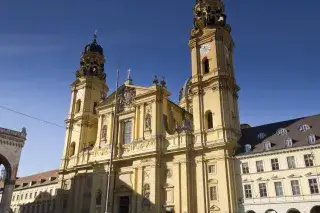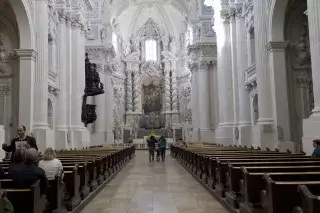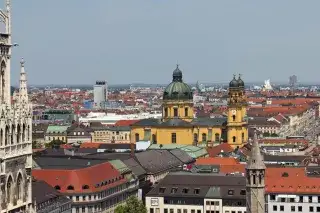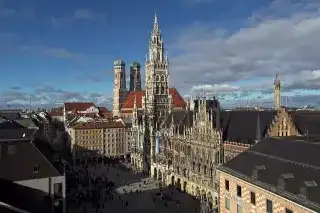Bavaria's first baroque church in the center of Munich
Theatiner Church (St. Kajetan) at Odeonsplatz: All you need to know
The Theatinerkirche at Munich's central Odeonsplatz shines bright yellow - Bavaria's first baroque church also impresses with its interior.

More actions
Overview of the Theatiner Church (St. Kajetan)
- Building history: In 1663, the Italian Agostino Barelli began building the court and monastery church of St. Kajetan in the Baroque style. It was consecrated in 1675 while still in its shell state. It was not until over 100 years later that Cuvilliés the Younger completed the facade in 1768 in the Rococo style.
- Location: The Theatinerkirche is located in the center of Munich on the west side of the Odeonsplatz, next to the Feldherrnhalle and opposite the Residenz.
- The name: Today's court and collegiate church is dedicated to St. Kajetan. However, the Theatinerkirche received its name from the people of Munich through the Theatin priests who worked in the church from 1675 to 1801.
- Attractions: The magnificent exterior façade, the princely crypt of the Wittelsbach dynasty, the 70-meter-high dome, the Theatinerhof (currently being renovated)
Eye-catcher on Odeonsplatz: The yellow rococo facade

The ocher-yellow facade is one of the most beautiful in the entire city and dominates Odeonsplatz. It is completed by the copper roofs of the two 64 meter high towers and the mighty 70 meter high dome.
The design was done by Francois Cuvilliés the Elder and Francois Cuvilliés the Younger from 1765 to 1768, the figures and the decoration are by R. A. Boos. The Theatinerhof adjoins the left side, the former tract of the monastery will be generally renovated until 2022.
Church services in the simple interior

Upon entering the interior, most visitors are initially surprised. It is very simple in terms of color scheme, kept entirely in white. The spectacular thing about the interior, which was built in 1674 under Lorenzo Petri and Giovanni Viscardi, is the decorative design with massive columns, filigree stucco and the mighty dome 70 meters above the ground.
Of particular impact for visitors and during church services is the majestic high altar with its larger-than-life statues.
The Wittelsbacher crypt: This is where important nobles are buried
Alongside the Church of St. Michael and the Cathedral Church of Our Lady (Frauenkirche), the Theatinerkirche is one of the most important burial places of the Bavarian ruling dynasty of the Wittelsbacher.
A total of 49 members of the ruling family are buried in the Fürstengruft, including four electors, three kings, Prince Regent Luitpold and Emperor Karl VII.
The history of the Theatiner Church

Like Nymphenburg Palace , the Theatiner Church and the adjoining monastery were built in gratitude for a happy birth: The future Elector Max Emanuel had just been born when his mother Henriette Adelheid von Savoy commissioned the "most beautiful and valuable church" from the Italian Agostino Barelli in 1662.
Construction work began in April 1663. Due to violent disputes between Barelli and the construction manager, Enrico Zuccalli took over the artistic direction in 1674.
At the consecration on June 11, 1675, the Theatiner Church was still in the shell stage. It was not until 1688 that the nave was completed, the towers following in 1690.
But the discussions continued and so the outer facade remained unfinished for a long time. It was not until about 100 years after the foundation stone was laid that François de Cuvilliés the Elder designed a facade in the Rococo style in 1765, with only slight changes, which his son François de Cuvilliés the Younger completed in 1768.
During World War II , the church was severely destroyed in 1944/45 and rebuilt from 1946 to 1955. From 2014 to 2019, it was renovated again and received a new coat of yellow paint.
At a glance
Theatiner Church (St. Kajetan) at Odeonsplatz: All you need to know
Theatinerstr. 22
80333
München
Tel:
+49892106960
Barrier-free access
Barrier-free accessibility in the building
Accessibility - further information



